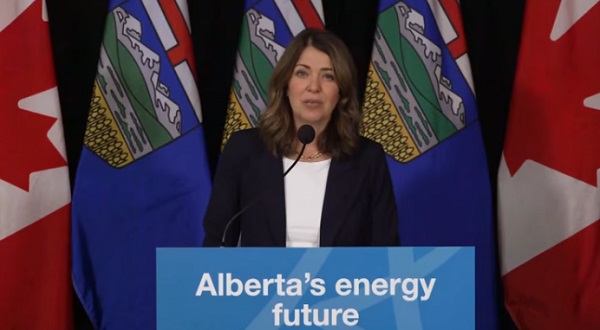Brownstone Institute
Karma Catches Up to the Stanford Internet Observatory

From the Brownstone Institute
By
Karma has caught up with the Stanford Internet Observatory (SIO), which will be scaled back to just three staff, according to the Washington Post. The contracts of its leading protagonists, Alex Stamos and Renee DiResta, have not been renewed. It was former CIA fellow Renee DiResta who led SIO’s signature initiatives, the Election Integrity Partnership (EIP) and the Virality Project (VP).
SIO’s demise is a result of a string of efforts including those of Racket, Public, the Murthy v. Missouri plaintiffs, the New Civil Liberties Alliance, the Disinformation Chronicle, the Subcommittee on the Weaponization of the Federal Government, and many more. Network Affects also contributed original research.
Founded with a $5 million donation from Craig Newmark, SIO took countering “misinformation” to new heights; the Virality Project advised its Big Tech partners to consider “true stories” to be “misinformation:”

I unearthed that document while assisting Matt Taibbi with Twitter Files research, just in time for his and Michael Shellenberger’s testimony before the Select Subcommittee on the Weaponization of the Federal Government. It is perhaps the most egregious example of the internet research and digital rights fields 180°– an inorganic flip that undermined a decades-long commitment to free expression.
Inorganic because the EIP and VP were not “research initiatives” as is often claimed; they were seeded by the security state, namely the Department of Homeland Security and the Cybersecurity and Infrastructure Security Agency, as demonstrated by emails released by the House Committee on the Weaponization of the Federal Government. Below the Atlantic Council’s Graham Brookie (an EIP/VP project partner) explains that “we just set up an election integrity partnership at the request of DHS/CISA:”

The Atlantic Council is essentially NATO’s think tank and its board includes Pfizer CEO Albert Bourla, former Director of National Intelligence James Clapper, former Secretary General of NATO the Rt. Hon. Lord Robertson, former US Secretary of Defense and CIA Director Leon Panetta, Goldman Sachs Secretary of the Board John F. W. Rogers, and many, many more.
As Taibbi further demonstrated, Twitter was aware of EIP’s links to the intelligence community:

So when content takedown recommendations came onto Twitter, they knew they were more than just serving suggestions.
The content of those requests was made clear after SIO was forced to release details of their internal flagging system. This again, via Taibbi’s reporting:

Furthermore, VP was in close contact with the White House and hosted Surgeon General Murphy for a discussion on health “misinformation.”
They also had pipeline-level access to more than 50 million Covid-related tweets per day:

This was in no way an insignificant research project.
VP pushed to censor other academics, such as Martin Kuldorff, a former Harvard Professor of Epidemiology and former member of the CDC’s Vaccine Safety Subgroup. As Alex Gutentag and I reported, VP “played a major role” in censoring Kuldorff. On March 15, 2021, Kulldorff tweeted, “Thinking that everyone must be vaccinated is as scientifically flawed as thinking that nobody should. COVID vaccines are important for older high-risk people, and their care-takers. Those with prior natural infection do not need it. Nor children.”
VP flagged the tweet to Twitter and it was subsequently labelled as “misleading” and Kuldorff was temporarily suspended from the platform.” VP also marked him as a “repeat offender.”
However many outlets describe SIO’s demise as the result of “sustained right-wing campaign” by “conservative outlets” and ignore the corruption at the heart of the project. Predictably Stanford, DiResta, Stamos, and their supporters shout “Everything is right-wing” as they scramble to come up with a narrative that deflects accountability for their actions.
The truth is just that SIO was doing something egregiously wrong and was targeting people regardless of ideology. Those reporters could easily find that out – the lead tweet of Taibbi’s House testimony has been viewed more than 40 million times:

Stamos and DiResta will of course find other work. Stamos already has, starting a company with former CISA head Chris Krebs. Meanwhile, DiResta has a new book out – endorsed surprisingly by Jonathan Haidt, who was also among the top signatories of the Westminster Declaration. Despite SIO crumbling accountability still appears to be sorely lacking. DiResta appeared top of the bill at a recent Yale conference on propaganda.
It should never have gone this far; a properly self-regulating anti-disinformation field would have sniffed out bad actors early, but the conversation and the ecosystem are broken. SIO shouldn’t be the last center to be shut down or see leadership changes. Breaking basic research ethics, hiding your relationship with government and intelligence agencies, protecting corporate products from proper scrutiny, and pushing for the censorship of other academics is not “free academic inquiry” or “free speech;” it is corruption.
My non-profit, liber-net, will be strengthening our efforts over the coming months to bring accountability to other leading civil society censorship initiatives.
Meanwhile, SIO leaves a malign legacy, having damaged the reputation of the anti-disinformation field, and academia more broadly. The question is, will the anti-disinformation field clean house, or continue to ignore the corruption within its ranks?
Links to my past Stanford Internet Observatory and Virality Project-related content can be found below.
Stanford’s Virality Project pushed to censor the vaccine-injured
The Virality Project was a government front to coordinate censorship
Twitter Files Extra: How the World’s “No-Kidding Decision Makers” Got Organized
Republished from the author’s Substack
Brownstone Institute
Bizarre Decisions about Nicotine Pouches Lead to the Wrong Products on Shelves

From the Brownstone Institute
A walk through a dozen convenience stores in Montgomery County, Pennsylvania, says a lot about how US nicotine policy actually works. Only about one in eight nicotine-pouch products for sale is legal. The rest are unauthorized—but they’re not all the same. Some are brightly branded, with uncertain ingredients, not approved by any Western regulator, and clearly aimed at impulse buyers. Others—like Sweden’s NOAT—are the opposite: muted, well-made, adult-oriented, and already approved for sale in Europe.
Yet in the United States, NOAT has been told to stop selling. In September 2025, the Food and Drug Administration (FDA) issued the company a warning letter for offering nicotine pouches without marketing authorization. That might make sense if the products were dangerous, but they appear to be among the safest on the market: mild flavors, low nicotine levels, and recyclable paper packaging. In Europe, regulators consider them acceptable. In America, they’re banned. The decision looks, at best, strange—and possibly arbitrary.
What the Market Shows
My October 2025 audit was straightforward. I visited twelve stores and recorded every distinct pouch product visible for sale at the counter. If the item matched one of the twenty ZYN products that the FDA authorized in January, it was counted as legal. Everything else was counted as illegal.
Two of the stores told me they had recently received FDA letters and had already removed most illegal stock. The other ten stores were still dominated by unauthorized products—more than 93 percent of what was on display. Across all twelve locations, about 12 percent of products were legal ZYN, and about 88 percent were not.
The illegal share wasn’t uniform. Many of the unauthorized products were clearly high-nicotine imports with flashy names like Loop, Velo, and Zimo. These products may be fine, but some are probably high in contaminants, and a few often with very high nicotine levels. Others were subdued, plainly meant for adult users. NOAT was a good example of that second group: simple packaging, oat-based filler, restrained flavoring, and branding that makes no effort to look “cool.” It’s the kind of product any regulator serious about harm reduction would welcome.
Enforcement Works
To the FDA’s credit, enforcement does make a difference. The two stores that received official letters quickly pulled their illegal stock. That mirrors the agency’s broader efforts this year: new import alerts to detain unauthorized tobacco products at the border (see also Import Alert 98-06), and hundreds of warning letters to retailers, importers, and distributors.
But effective enforcement can’t solve a supply problem. The list of legal nicotine-pouch products is still extremely short—only a narrow range of ZYN items. Adults who want more variety, or stores that want to meet that demand, inevitably turn to gray-market suppliers. The more limited the legal catalog, the more the illegal market thrives.
Why the NOAT Decision Appears Bizarre
The FDA’s own actions make the situation hard to explain. In January 2025, it authorized twenty ZYN products after finding that they contained far fewer harmful chemicals than cigarettes and could help adult smokers switch. That was progress. But nine months later, the FDA has approved nothing else—while sending a warning letter to NOAT, arguably the least youth-oriented pouch line in the world.
The outcome is bad for legal sellers and public health. ZYN is legal; a handful of clearly risky, high-nicotine imports continue to circulate; and a mild, adult-market brand that meets European safety and labeling rules is banned. Officially, NOAT’s problem is procedural—it lacks a marketing order. But in practical terms, the FDA is punishing the very design choices it claims to value: simplicity, low appeal to minors, and clean ingredients.
This approach also ignores the differences in actual risk. Studies consistently show that nicotine pouches have far fewer toxins than cigarettes and far less variability than many vapes. The biggest pouch concerns are uneven nicotine levels and occasional traces of tobacco-specific nitrosamines, depending on manufacturing quality. The serious contamination issues—heavy metals and inconsistent dosage—belong mostly to disposable vapes, particularly the flood of unregulated imports from China. Treating all “unauthorized” products as equally bad blurs those distinctions and undermines proportional enforcement.
A Better Balance: Enforce Upstream, Widen the Legal Path
My small Montgomery County survey suggests a simple formula for improvement.
First, keep enforcement targeted and focused on suppliers, not just clerks. Warning letters clearly change behavior at the store level, but the biggest impact will come from auditing distributors and importers, and stopping bad shipments before they reach retail shelves.
Second, make compliance easy. A single-page list of authorized nicotine-pouch products—currently the twenty approved ZYN items—should be posted in every store and attached to distributor invoices. Point-of-sale systems can block barcodes for anything not on the list, and retailers could affirm, once a year, that they stock only approved items.
Third, widen the legal lane. The FDA launched a pilot program in September 2025 to speed review of new pouch applications. That program should spell out exactly what evidence is needed—chemical data, toxicology, nicotine release rates, and behavioral studies—and make timely decisions. If products like NOAT meet those standards, they should be authorized quickly. Legal competition among adult-oriented brands will crowd out the sketchy imports far faster than enforcement alone.
The Bottom Line
Enforcement matters, and the data show it works—where it happens. But the legal market is too narrow to protect consumers or encourage innovation. The current regime leaves a few ZYN products as lonely legal islands in a sea of gray-market pouches that range from sensible to reckless.
The FDA’s treatment of NOAT stands out as a case study in inconsistency: a quiet, adult-focused brand approved in Europe yet effectively banned in the US, while flashier and riskier options continue to slip through. That’s not a public-health victory; it’s a missed opportunity.
If the goal is to help adult smokers move to lower-risk products while keeping youth use low, the path forward is clear: enforce smartly, make compliance easy, and give good products a fair shot. Right now, we’re doing the first part well—but failing at the second and third. It’s time to fix that.
Addictions
The War on Commonsense Nicotine Regulation

From the Brownstone Institute
Cigarettes kill nearly half a million Americans each year. Everyone knows it, including the Food and Drug Administration. Yet while the most lethal nicotine product remains on sale in every gas station, the FDA continues to block or delay far safer alternatives.
Nicotine pouches—small, smokeless packets tucked under the lip—deliver nicotine without burning tobacco. They eliminate the tar, carbon monoxide, and carcinogens that make cigarettes so deadly. The logic of harm reduction couldn’t be clearer: if smokers can get nicotine without smoke, millions of lives could be saved.
Sweden has already proven the point. Through widespread use of snus and nicotine pouches, the country has cut daily smoking to about 5 percent, the lowest rate in Europe. Lung-cancer deaths are less than half the continental average. This “Swedish Experience” shows that when adults are given safer options, they switch voluntarily—no prohibition required.
In the United States, however, the FDA’s tobacco division has turned this logic on its head. Since Congress gave it sweeping authority in 2009, the agency has demanded that every new product undergo a Premarket Tobacco Product Application, or PMTA, proving it is “appropriate for the protection of public health.” That sounds reasonable until you see how the process works.
Manufacturers must spend millions on speculative modeling about how their products might affect every segment of society—smokers, nonsmokers, youth, and future generations—before they can even reach the market. Unsurprisingly, almost all PMTAs have been denied or shelved. Reduced-risk products sit in limbo while Marlboros and Newports remain untouched.
Only this January did the agency relent slightly, authorizing 20 ZYN nicotine-pouch products made by Swedish Match, now owned by Philip Morris. The FDA admitted the obvious: “The data show that these specific products are appropriate for the protection of public health.” The toxic-chemical levels were far lower than in cigarettes, and adult smokers were more likely to switch than teens were to start.
The decision should have been a turning point. Instead, it exposed the double standard. Other pouch makers—especially smaller firms from Sweden and the US, such as NOAT—remain locked out of the legal market even when their products meet the same technical standards.
The FDA’s inaction has created a black market dominated by unregulated imports, many from China. According to my own research, roughly 85 percent of pouches now sold in convenience stores are technically illegal.
The agency claims that this heavy-handed approach protects kids. But youth pouch use in the US remains very low—about 1.5 percent of high-school students according to the latest National Youth Tobacco Survey—while nearly 30 million American adults still smoke. Denying safer products to millions of addicted adults because a tiny fraction of teens might experiment is the opposite of public-health logic.
There’s a better path. The FDA should base its decisions on science, not fear. If a product dramatically reduces exposure to harmful chemicals, meets strict packaging and marketing standards, and enforces Tobacco 21 age verification, it should be allowed on the market. Population-level effects can be monitored afterward through real-world data on switching and youth use. That’s how drug and vaccine regulation already works.
Sweden’s evidence shows the results of a pragmatic approach: a near-smoke-free society achieved through consumer choice, not coercion. The FDA’s own approval of ZYN proves that such products can meet its legal standard for protecting public health. The next step is consistency—apply the same rules to everyone.
Combustion, not nicotine, is the killer. Until the FDA acts on that simple truth, it will keep protecting the cigarette industry it was supposed to regulate.
-

 Alberta16 hours ago
Alberta16 hours agoFrom Underdog to Top Broodmare
-

 Alberta2 days ago
Alberta2 days agoAlberta and Ottawa ink landmark energy agreement
-

 International2 days ago
International2 days agoAfghan Ex–CIA Partner Accused in D.C. National Guard Ambush
-

 Carbon Tax2 days ago
Carbon Tax2 days agoCanadian energy policies undermine a century of North American integration
-

 International2 days ago
International2 days agoIdentities of wounded Guardsmen, each newly sworn in
-

 Alberta2 days ago
Alberta2 days agoWest Coast Pipeline MOU: A good first step, but project dead on arrival without Eby’s assent
-

 COVID-191 day ago
COVID-191 day agoCanadian government seeking to destroy Freedom Convoy leader, taking Big Red from Chris Barber
-

 Energy2 days ago
Energy2 days agoPoilievre says West Coast Pipeline MOU is no guarantee









